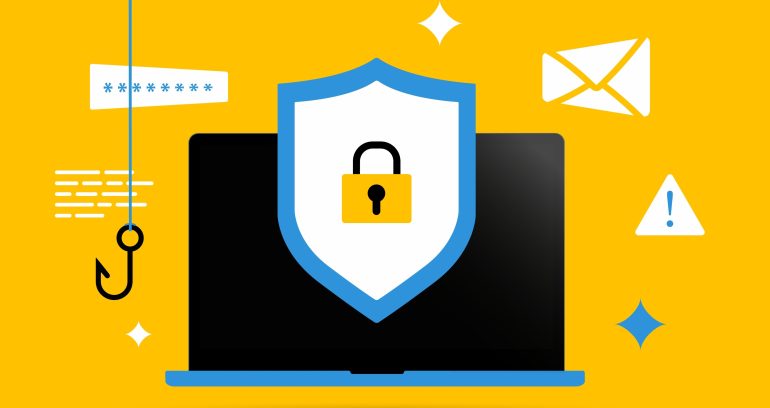Cybersecurity can seem like a daunting topic. But a strong defense against cybercriminals in 2024 is a non-negotiable. Compared to large companies, SMEs are easy prey and are therefore increasingly the target of cybercrime. And although the number of victims of cybercrime and the damage caused is increasing, too many organizations are still nonchalant about their digital security.
How can you better protect your organization against cybercrime? Start with these 4 basic steps.
1. Passwords, password manager & MFA
Passwords are often the first line of defense against cyber attacks. Unfortunately Too many organizations continue to use weak passwordssuch as reusing passwords and using predictable passwords. Therefore, start by implementing a strong password policy, combined with Multi-Factor Authentication (MFA).
Create a strong password policy
A strong password policy must include the following:
- Long passwords: Use passwords of at least 14 characters. The longer the password, the harder it is to crack.
- Complexity: Combine uppercase, lowercase, numbers, and special characters. Avoid obvious patterns and words that are easy to guess.
- Unique passwords: Avoid reusing passwords across accounts. If one password is compromised, all accounts become vulnerable.
- Password Manager: To store all passwords safely and effectively, I recommend using a password manager to use.
For a ready-made password policy that can be implemented right away, visit the following resource: Download password policy.
Multi-Factor Authentication (MFA)
MFA adds an extra layer of security by requiring not only a password, but also a second form of authentication. This could be a one-time code sent to the user’s phone, a biometric authentication such as a fingerprint, or a physical security key.
MFA ensures that even if a password is stolen, the attacker cannot simply gain access to the system. A strong password combined with MFA reduces the chance of an account attack by 99%.
2. Back-ups
Have you ever lost an important document because your computer suddenly stopped working? Annoying, huh? Now imagine something like that happening on a larger scale within your company, caused by a cyber attack or a technical defect. Without a solid backup plan, this could lead to irreparable loss of crucial company data. We want to prevent that at all costs.
Best practices for an effective backup policy
- Regular backups: Ensure that all critical business data is backed up regularly. This can be daily or weekly, depending on the amount and importance of the data.
- Off-site and cloud backups: Store backups in a secure, off-site location or in the cloud. This protects your data from physical threats such as fire or theft.
- Encryption: Encrypt your backups to prevent unauthorized access to sensitive information, even if the backup is stolen.
- Testing recovery procedures: Regularly test your backups by running recovery procedures. This will ensure that you can recover quickly and effectively in the event of an emergency.
Backups can be complicated. Given how important backups are to your security strategy, I recommend that you outsource this issue to your own trusted IT partner.
3. Employees
Your employees are both your greatest asset and a potential risk when it comes to cybersecurity. 90% of the time, human error, such as clicking on a phishing link or sharing passwords, is the cause. the cause of security incidents. That’s why it’s important to make your team aware of the risks and provide them with the right training and tools. But how do you do this?
Make employees aware
Cybersecurity starts with awareness. Employees need to understand why certain rules and procedures exist and how their actions can impact the security of the organization. Regular training and updates on the latest threats, such as phishing and ransomwareare of great importance.
- Phishing simulations: Run regular phishing simulations to test your employees’ alertness and train them to recognize suspicious emails.
- Continuous learning: Cybersecurity is not a one-time exercise. Ensure your employees are continuously learning and staying up to date with the latest developments and threats.
- Cyber culture change: cyber security should be a shared responsibility. Encourage reporting of suspicious activity and provide clear guidelines for safe working, both in the office and at home.
Making your employees aware and training them requires a specialist approach. For this step I therefore recommend working with a professional party to tackle this effectively.

4. Automatic updates
Outdated software is one of the biggest vulnerabilities within companies. Hackers often take advantage of known security holes in unupdated software. Regularly updating software is therefore essential to protect your systems against new threats.
Automatic updates are the most efficient way to ensure that your software is always up to date without the need for manual actions. This minimizes the risk of human error and ensures that your systems are continuously protected against the latest threats.
Best practices automatic updates
- Enable automatic updates: Ensure that all company equipment and software are updated automatically. This includes operating systems, applications, and security software.
- Manage exceptions: For software that you can’t update automatically, you can set a strict update policy. Make sure to check regularly.
Automatic updates are easy to set up in most cases and provide a strong defense if configured properly.
Take action for a cyber-secure future
Cyber threats will continue to increase in the coming period, the effectiveness of attacks will improve and the damage will increase. It is therefore time to take responsibility to protect your own, but also the future of your organization!
How many of the basic steps has your organization already implemented?
Source: www.frankwatching.com


